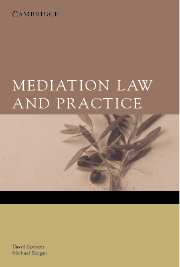Book contents
- Frontmatter
- Contents
- Acknowledgements
- Preface
- List of tables and figures
- Table of statutes
- Table of cases
- PART I THE PRACTICE OF MEDIATION
- 1 Mediation: Its Definition and History
- 2 The Mediation Process
- 3 The Theory and Philosophy of Mediation
- 4 Specific Types of Mediation
- 5 The Mediator
- 6 The Ethics of Mediation
- 7 Power, Empowerment and Difference in Mediation
- PART II THE LAW OF MEDIATION
- Bibliography
- Index
4 - Specific Types of Mediation
Published online by Cambridge University Press: 05 June 2012
- Frontmatter
- Contents
- Acknowledgements
- Preface
- List of tables and figures
- Table of statutes
- Table of cases
- PART I THE PRACTICE OF MEDIATION
- 1 Mediation: Its Definition and History
- 2 The Mediation Process
- 3 The Theory and Philosophy of Mediation
- 4 Specific Types of Mediation
- 5 The Mediator
- 6 The Ethics of Mediation
- 7 Power, Empowerment and Difference in Mediation
- PART II THE LAW OF MEDIATION
- Bibliography
- Index
Summary
Introduction
It is clear that the classical mediation model is a useful tool for settling disputes however, it is not always the case that there is a perfect fit between the needs of the parties and that classical model: modification to suit the interests of the parties is required (see Steer 1997). We have noted that mediation is a process that can be flexible and cater to the circumstances and needs of the parties. The differences in approach adopted in mediations in distinct settings are important, as they highlight the hybrid nature of mediation and its effectiveness when allowed to develop to fit the demands of a particular type of dispute. In this chapter we will discuss the way in which mediation can be used in seven areas of life: commercial, family, community, cross-cultural, building and construction, and health care mediation, as well as the developing area of victim–offender mediation or conferencing.
Commercial mediation
Commercial mediation is typified by a ‘cut and thrust’ approach, the ‘time is money’ mantra suggesting that many businesses are keen to finalise any dispute quickly and avoid the time- and money-wasting aspect of litigation. Commercial mediations are stereotypically seen to be more results oriented, with the mediator being more robust (see chapter 5) in driving the parties to an agreement. In the next extract Maureen Garwood, negotiator and mediator, interviewed 16 commercial mediators and the parties involved in mediated disputes.
- Type
- Chapter
- Information
- Mediation Law and Practice , pp. 125 - 154Publisher: Cambridge University PressPrint publication year: 2007



